Global high-mix volume high-speed Shenzhen PCBA manufacturer

Ru
9:00 -18:00, Mon. - Fri. (GMT+8)
9:00 -12:00, Sat. (GMT+8)
(Except Chinese public holidays)





Global high-mix volume high-speed Shenzhen PCBA manufacturer

Ru
9:00 -18:00, Mon. - Fri. (GMT+8)
9:00 -12:00, Sat. (GMT+8)
(Except Chinese public holidays)





HomePage > Blog > Knowledge Base > BC547 Pinout - A Comprehensive Guide
BC547 is one of the most common NPN bipolar junction transistors (BJT) found in today's electronics world. It is prevalent, ranging from simple switching devices to high-power audio amplifiers. It is budget friendly and very reliable, due to these reasons, it is popular among numerous circuits. To interact with electronic circuits intelligently, it is essential to understand the BC547 pinout configuration.
The pin assignment for the BC547 transistor is very Important. An incorrect assignment could damage our circuit or even destroy the component, leading to errors and wasted time. It contains the TO-92 package with three pins. Identifying which pin is the collector, base, or emitter is critical to the project's completion.
The BC547 Transistor is part of the BC54X transistor family, mostly used for general-purpose switching and amplification. As we discussed, it is an NPN transistor; the current flows from the collector to the emitter after receiving enough current at the base pins. This fundamental principle ensures reliability in all types of electronics.
Before we get into the specific traits of the BC547 transistor, we need to discuss its pinout configuration. BC547 transistor pinouts and features are the basis for successful electronic projects. This blog will help you if you’re designing your first circuit or want to improve your electronics expertise.
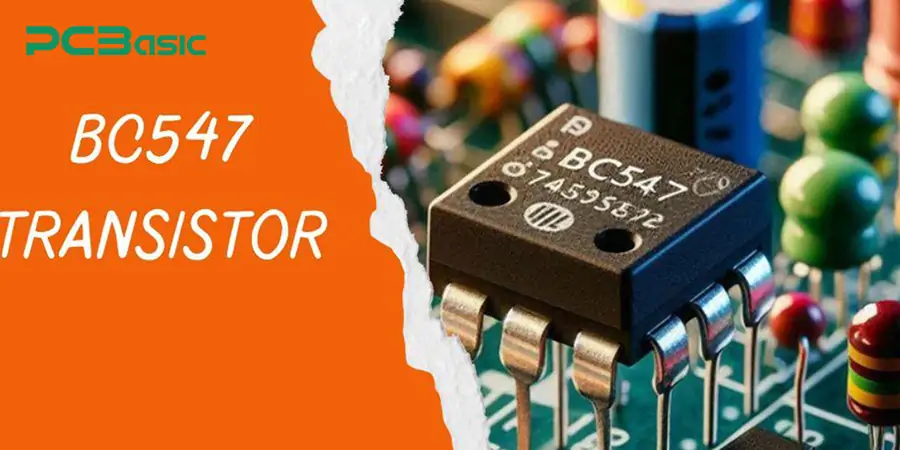
BC547 stands as a classic NPN BJT, which now becomes the foundation for electronic designs. Philips made this transistor in the plastic-molded version of the metal BC107. Its versatility and low costs have made it an alternative for designers.
The NPN design of the BC547 Transistor allows us to control a large collector emitter current through a small base current. This basic feature makes it perfect for switching and reinforcement functions. The important factors that have kept the BC547 transistor relevant are:
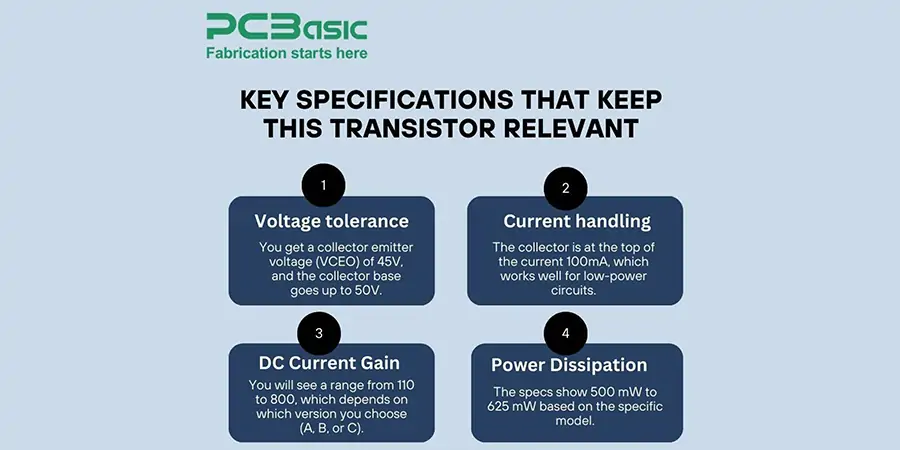
BC547 transistor acts as the power amplifier with accurate signal and enhancement. It is also used for driver stages in sound amplifiers, low-noise entrance stages of tape recorders, high-Fi amplifiers, and signal-processing circuits
You'll find the BC547 transistor in a preferred TO-92 package with 3 pins. This layout works flawlessly for through-hole mounting on Printed Circuit Boards and breadboards. The TO-92 package contains many benefits:
The TO-92 package width is between 4.32 and 5.33mm, its depth is between 4.45 and 5.20mm deep. It has three pins in a straight line at the bottom. Due to these characteristics, we can be use it in different circuit designs as per requirement.

Pin configuration plays an important role in working with the BC547 transistor. The configuration may look simple, but incorrect connections can damage components or cause circuit errors.
The pinout of BC547 follows a sequential numbering from 1 to 3 when viewed in TO-92 packages from the flat surface. The manufacturers specify in the data sheet that the correct numbering moves from left to right, looking at the flat side with a fastening tone.
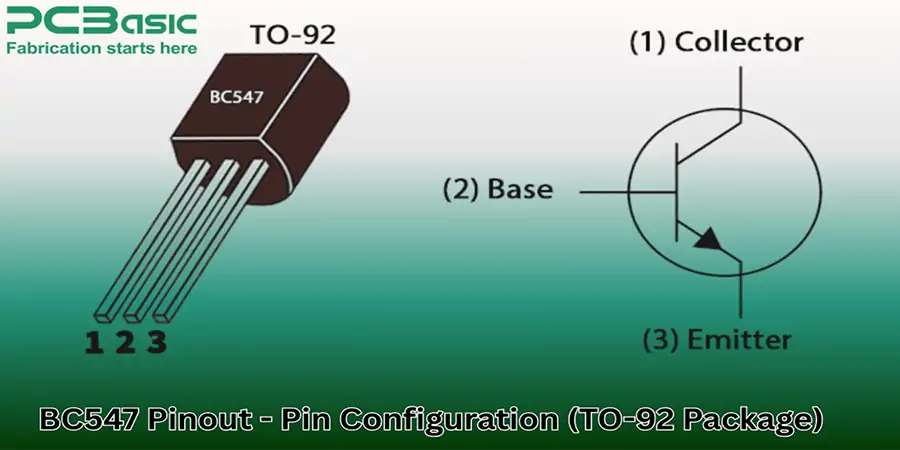
BC547 transistors contain the three pins that correspond to the standard BJT terminal system. Each PIN code performs a specific function that determines the operation of the transistor. The TO-92 package arranges these terminals in a sequence that sets it apart from other transistors. Circuit integration requires a clear understanding of this.
The collector (Pin 1) of BC547 acts as a power input for transistors. The current enters into the transistor from this terminal. Switching applications connect the collector to the load, while the amplifier configurations use it as an output.
Pin 2 is the base of BC547. The bias of this checks the current flow between the collector and the emitter. The amplification of the transistor works according to a basic principle - a small base current controls a very large transistor current.
The Pin 3 is the emitter of the BC547 Transistor. It acts as the current outlet of the transistor. It completes the terminal circuit path because the current exits the transistor from this. Standard circuit configurations usually link the emitter to the ground or reference capacity.
The BC547 pinout shows three pins at the bottom of the TO-92 package, as shown in the above Image. If the flat side is toward the face and we take from left to right, that is the collector (C), base (B), and emitter (s). Circuit design depends on this standard setup.

BC547 behaves like a typical NPN transistor. The collector and emitter remain open (reverse biased). An indication applied to the base stops them (forward biased).
For amplification, the base-emitter junction must be forward biased, allowing linear operation and distortion-free signal amplification. This allows distortion-free signal amplification. Switching applications drive the transistor into saturation, causing a short circuit with a minimum drop between the collector and the emitter.
BC547 Transistor Key specifications play an important role in calculating circuit parameters and finding the right applications. Circuit designers can guess how it will behave under different circumstances by looking at its electrical properties.
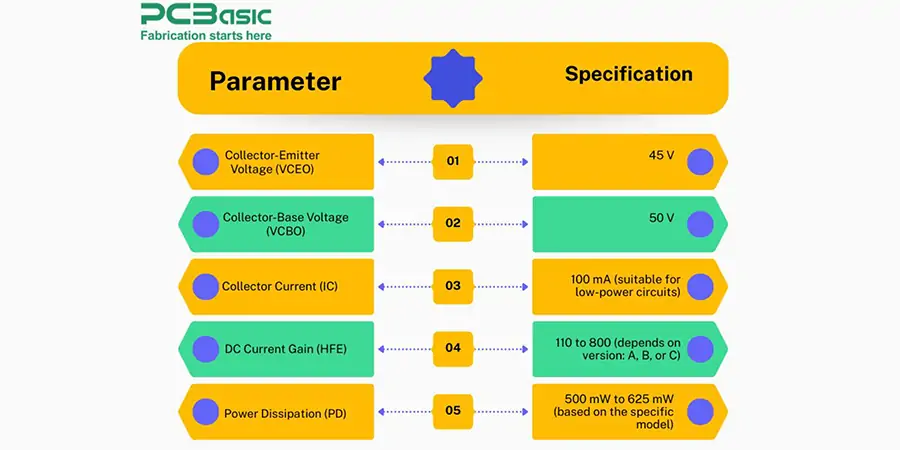
The thermal specifications of BC547 are equally important. It works firmly between -55 ° C and +150 ° C cross temperatures. These thermal boundaries mean you can use it in many different environments.
The frequency reaction is another important imagination. The transition frequency (FT) usually comes between 100-300MHz depending on operating conditions. The collector-base capacitance (CCB) of 4.5PF affects the emitter base capacitance (Ceb) at 10PF and how well it works on high frequencies.
The properties of the noise separated BC547 from other options. The noise figure remains below 10dB of 1 khz, which does well when you need clean sound signals.
Collector-emitter saturation voltage VCE (SAT) lives below 0.7V with 10 mA collector current, so it effectively replaces with minimum power waste. Base-emitter voltage (VBE) usually runs between 0.55V and 0.7V during surgery.
A multimeter is a great way to help identify the stick on an unknown or untouched transistor. The right pin configuration protects the circuit from damage that can receive the price.
A digital multimeter with diode test mode gives the most reliable results. The simple analog multimeter can also work if you use the right technique.
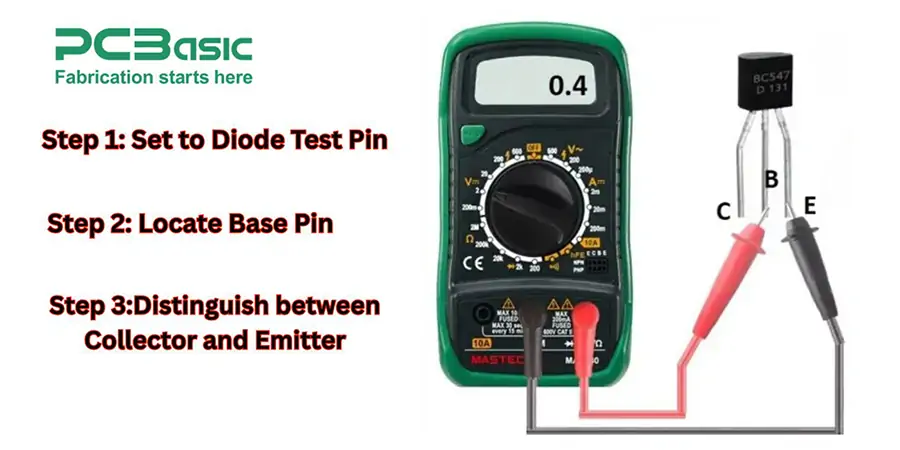
BC547 PIN identification requires systematic testing of semiconductors junction inside the transistor. NPN transistors' cross functions help determine each stick with accuracy:
Step 1: Set your multimeter to diode testing mode. Turn the selector dial to the diode testing position (usually marked with a diode symbol). This mode applies a small voltage across the probes and shows the resulting voltage drop.
Step 2: Locate the base pin
1. Hold the transistor with the flat side facing you and the pins pointing downward
2. Test all possible pin combinations by connecting the multimeter probes to any two pins
3. Record which combinations show a voltage drop (typically 0.6- 0.7V)
4. The pin that shows forward bias with both other pins is your base (Pin 2)
Step 3: Distinguish between collector and emitter. After finding the base pin, you'll need more testing to identify the collector and emitter:
5. Connect the multimeter's red probe to the base
6. Touch the black probe to one of the remaining pins
7. If the reading shows approximately 0.7V, you've found a base-emitter or base-collector junction
8. Repeat with the other unknown pin
The base-emitter junction usually shows a slightly lower forward voltage than the base-collector junction. You can identify the collector with the high reverse leakage flow.
PIN compatibility must be considered when choosing an alternative transistor. BC547 is now available to more people, and by knowing the compatible options, you get more design flexibility and troubleshooting options.

BC547 acts as an NPN, and BC557 acts as a PNP transistor. Both transistors TO-92 use similar packaging but have different internal structures and operating properties.
Their pinout arrangements differ significantly.BC547 uses a CBE (Collector-base-Emitter) configuration, while BC557 follows an EBC (Emitter-base-Collector) pinout. This significant difference means that the pins reverse between these models so that the circuiting becomes necessary when replacing one for the other.
Both transistors distribute uniform electrical performance properties with the opposite polarity. BC557 can handle comparable voltage and power assessments but works along the negative collector voltage and reverse power flow compared to BC547.
Pin compatibility becomes more important with alternatives such as 2N3904 or 2N2222. 2N3904 uses the same EBC pinout as BC557, making it inconsistent as a direct BC547 substitute without changing the circuit. 2N2222 BC547 matches the CBE pinout, which allows easy replacement in most applications.
These options provide different performance glasses beyond their pinout difference. 2N2222 handles high current (800mA vs BC547's 100mA), while 2N3904 performs better at high frequencies.
BC547 can be replaced with alternative transistors through multiple methods:
1. Direct substitution: Select Options with Uniform CBE -Pinouts (2N2222, BC546, BC548)
2. Pin bending: Bend pins on transistors that are different pinouts to match the circuit connection
3. Circuit modification: Change circuit board cabling to fit different Pinouts
4. Adapter creation: Build a custom adapter for inconsistent transistors that you often use
Any physical equality should be tested before any replacement. The transistor with a matching pinout may have different performance characteristics or voltage assessments that can affect how your circuit works.
The BC547 transistor proves to be invaluable in different types of electronic applications. We used it a lot as both an amplifier and a switch. Electronics engineers and hobbyists prefer this component of their designs as it provides impressive performance at a budget-friendly price.
The BC547 handles loads under 100mA exceptionally well in switching configurations. This feature works great for:
● LED driver circuits that control brightness by changing the base current
● Relay drivers that activate electromagnetic switches
● Motor control applications that use pulse-width modulation (PWM)
Signal processing circuits benefit from the possibilities of BC547. The proper combination of opponents, capacitors, and inductors helps generate stable fluctuations with accurate frequency properties. This oscillator circuit powers a clock generator, signal generator, and various communication systems.
The way I love BC547 is the use of its touch-sensitive switch. This treats signals from touch sensors to enable smart device control. The switching behavior to the transistor allows an automatic identification and response in the water level indicators and humidity-sensitive alarm systems.
The reliable performance of BC547 in oscillators, amplifiers, and switching applications makes it an important component of any electronics tool set.
The BC547 transistor, with its well-defined CBE pin configuration and robust NPN characteristics, remains a staple in the toolbox of both novice and experienced electronics engineers. Its TO-92 package simplifies integration into breadboards and PCBs, while its electrical specifications, including high gain, low noise, and reliable thermal performance, support a wide array of applications from precision amplification to efficient low-power switching.
Understanding and correctly identifying the BC547 pinout is essential not just for optimal functionality but also to avoid circuit failures or device damage. Whether you're designing analog front ends, driving LEDs, or working on small-signal amplification, the BC547 delivers consistent performance with impressive versatility.
BC547 Transistor compatibility with standard transistor replacements, when properly matched by pin configuration and electrical ratings, further enhances its utility across various prototyping and production environments. BC547 remains popular as it fully combines reliability, low costs, and versatility. Now that you know the BC547 Pinouts and BC547 properties, you can use this versatile component safely in your next electronic project.

Assembly Enquiry
Instant Quote